Eye alignment plays an important role in how we see and perceive the world. When both eyes work together, they create a single, clear, and three-dimensional image. However, in some individuals, one eye may deviate inward, outward, upward, or downward — a condition known as Squint (Strabismus).
One of the most common questions patients and parents ask is, “Can squint be corrected without surgery?” The good news is that in many cases, non-surgical treatments can effectively correct or manage squint, depending on the cause and severity.
At Gobind Nursing Home, under the expert guidance of Dr. Gulshan Mehta, one of the leading Squint Specialists, each case is carefully evaluated to determine whether non-surgical options can restore proper eye alignment and vision. This article explains how squint can be treated without surgery, when surgery becomes necessary, and what the best treatment options are for both children and adults.
Understanding Squint (Strabismus)
Squint, medically known as Strabismus, is a visual disorder in which both eyes do not align in the same direction. While one eye focuses on an object, the other may turn inward (esotropia), outward (exotropia), upward (hypertropia), or downward (hypotropia).
In children, squint often develops due to muscle imbalance, refractive errors, or developmental issues. In adults, it may occur due to nerve problems, trauma, or untreated childhood squint.
If left untreated, squint can cause problems such as lazy eye (Amblyopia), double vision, poor depth perception, and even psychological discomfort due to cosmetic concerns. However, early intervention and proper management can prevent these complications.
Dr. Gulshan Mehta emphasizes that every patient is unique, and not all squints require surgery. Many can be corrected or significantly improved through specialized non-surgical therapies.

When Can Squint Be Treated Without Surgery?
The possibility of treating squint without surgery largely depends on the underlying cause and type of misalignment. In mild or functional cases, non-surgical options can be highly effective, especially when the eye muscles are not severely imbalanced or when vision therapy can retrain the eyes to work together.
Non-surgical treatments are often successful in cases such as:
- Refractive Squint: Caused by uncorrected vision problems like farsightedness or nearsightedness.
- Intermittent Squint: When the misalignment appears occasionally.
- Functional Squint: Where the eyes can still coordinate to some extent.
- Squint due to Weak Eye Muscles: Correctable through exercises and therapy.
In such cases, at Gobind Nursing Home, we design customized treatment plans that focus on improving eye coordination, strengthening visual pathways, and achieving better alignment — without immediate surgical intervention.
Non-Surgical Treatments for Squint
Let’s explore the most effective non-surgical approaches available for managing or correcting squint:
1. Prescription Glasses or Contact Lenses
One of the most common non-surgical treatments for squint, especially in children, is the use of corrective lenses. Sometimes, squint develops as a result of uncorrected refractive errors such as hypermetropia (farsightedness).
Glasses or contact lenses help focus light properly on the retina, allowing both eyes to work together and align naturally. In some cases, the squint may disappear completely once the correct prescription is used.
At Gobind Nursing Home, the best eye surgeon, Dr. Gulshan Mehta performs detailed vision testing to determine if glasses alone can correct or improve the alignment issue.
2. Patching Therapy (For Lazy Eye or Amblyopia)
When squint is accompanied by lazy eye, the stronger eye may dominate, causing the weaker one to become less active. Patching therapy involves covering the stronger eye for a few hours each day, forcing the weaker eye to work harder.
This helps strengthen the visual connection between the eye and the brain, improving coordination and visual acuity. For children, patching therapy can be remarkably effective when started early.
3. Eye Exercises (Orthoptic Therapy)
Eye exercises, also known as orthoptic exercises, are designed to train the eyes to work together and improve muscle coordination. These exercises help enhance binocular vision and strengthen weak eye muscles.
Some examples include:
- Focus shifting between near and far objects
- Tracking moving targets
- Convergence exercises (bringing eyes inward)
- Computer-based vision therapy programs
Dr. Gulshan Mehta recommends personalized exercise plans after a detailed assessment of eye movement and coordination. Regular follow-up and consistency are key to achieving results.
4. Prism Lenses
Prism lenses are specially designed glasses that help align the two images seen by the eyes into one, thereby reducing double vision and improving comfort. These lenses don’t correct the muscle imbalance but help manage symptoms effectively in mild to moderate cases.
5. Botox Injections (Botulinum Toxin Therapy)
For certain types of squint, especially adult-onset squint, Botox (Botulinum Toxin) can be used as a temporary but effective non-surgical option. It is injected into an overactive eye muscle to relax it, allowing the eyes to realign naturally.
The effects usually last for several months, and in some cases, the alignment remains improved even after the effect wears off.

Benefits of Non-Surgical Squint Treatment
Non-surgical methods offer several advantages, particularly when treatment begins early and the squint is mild or moderate. Some benefits include:
- No surgical risks or recovery time
- Improved eye coordination and vision
- Enhanced aesthetic appearance in mild cases
- Effective management of intermittent or functional squint
- Suitable for both children and adults
- Can delay or even avoid the need for surgery
However, not all squints can be managed without surgery. If the misalignment is large, long-standing, or resistant to non-surgical methods, surgical correction may still be required for best results.
When Is Surgery Necessary?
While non-surgical treatments can be very effective in selected cases, Squint Surgery remains the most reliable and permanent solution for severe or complex squints.
Surgery is generally recommended when:
- The deviation is large or constant
- Non-surgical methods fail to correct alignment
- The squint causes double vision or eye strain
- There are cosmetic concerns affecting confidence
At Gobind Nursing Home, Dr. Gulshan Mehta performs advanced squint surgeries using minimally invasive techniques, ensuring precise alignment, improved eye coordination, and natural cosmetic appearance. The recovery is quick, and the results are long-lasting.
Can Adults Benefit from Non-Surgical Treatment?
Although squint treatment is most effective during childhood, adults can also benefit from non-surgical management. Prism glasses, vision therapy, or Botox injections can help manage symptoms such as double vision and mild misalignment.
For adults who have developed squint due to neurological or muscular issues, Dr. Gulshan Mehta provides customized solutions that improve both functional and cosmetic aspects of vision.
Importance of Early Diagnosis
The earlier a squint is detected, the better the chances of non-surgical correction. In children, timely intervention can prevent lazy eye, ensure proper visual development, and reduce the likelihood of needing surgery later.
Eye Specialists advise parents to have their child’s eyes checked regularly — ideally at 6 months, 3 years, and before starting school — to detect any signs of eye misalignment early.
Expert Squint Care at Gobind Nursing Home
Gobind Nursing Home is a trusted center for advanced eye care and squint management, offering both surgical and non-surgical solutions for all age groups. The hospital is equipped with state-of-the-art diagnostic and treatment facilities designed for accurate, comfortable, and effective care.
With years of experience, Dr. Gulshan Mehta provides specialized non-surgical squint correction through glasses, exercises, and modern therapies. His patient-first approach ensures that every individual receives a treatment plan tailored to their specific needs — aiming for clear vision, perfect alignment, and enhanced confidence.
So, can squint be corrected without surgery? In many cases — yes. Non-surgical treatments like glasses, exercises, patching therapy, prism lenses, and Botox injections can successfully correct or manage squint, particularly when diagnosed early.
However, for severe or persistent cases, surgery may still be the best solution to achieve stable, long-term alignment. The key is early evaluation and expert care.
At Gobind Nursing Home, Dr. Gulshan Mehta and his team offer comprehensive diagnostic and treatment services to help both children and adults regain perfect eye alignment and confident vision — with or without surgery.

